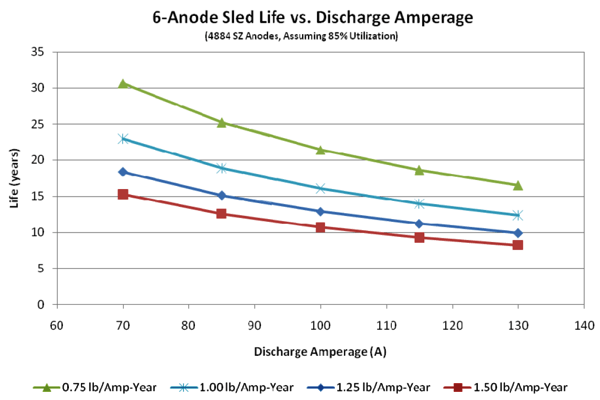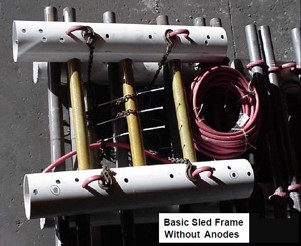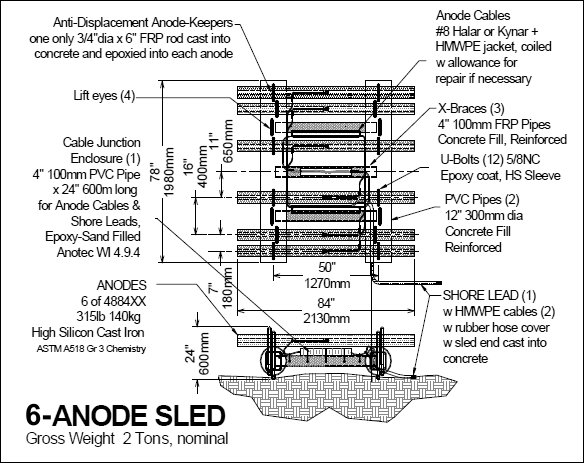HIgh Silicon Cast Iron Anode Sled, Heavy Duty, by Anotec

- Six-anode Heavy Duty Sled to Protect Offshore Structures
-
Anode sleds are designed to provide cathodic protection current to offshore structures such as oil platforms, piers, pilings, wharfs and similar. These structures usually require relatively high levels of cathodic protection current due to the saltwater environment, large amounts of steel and coating performance issues.
Anotec makes a sled that utilizes six (6) heavy high silicon cast iron (HSCI) anodes, each weighing 315 pounds (140 kg). The anodes are are securely mounted on a corrosion resistant PVC frame (sled), which in total weighs approximately 4,400 pounds (2000 kg), depending upon the size and length of anode cables. The physical footprint of the sled is approximately 7 ft. x 6.5 ft. x 2 ft. (2.1 m x 2.0 m x 0.6 m).

-
The following chart provides approximate sled performance.

Anodes are spaced for uniform current discharge and consumption. Although high silicon cast iron (HSCI) anodes in seawater can withstand current discharge amperages exceeding 5 A/sq ft. (55 A/sq m), the following factors should be considered:
- Environmental regulations may restrict sled discharge current to lower values. (i.e., less than 1 volt / meter electric field strength in natural waters).
- Sled life will depend upon the weight of anodes, the amperage, their consumption rate and utilization efficiency. For purposes of example only, the following values have been assumed to predict life expectancy, according to anode model (size) and sled current discharge (amps). Please refer to the above graph, which is based on:
- Consumption Rate Range: 0.75 lb / A-Yr (0.34 kg / A-yr) to 1.5 lb / Amp-Year (0.68 kg / Amp-Year).
- Utilization Efficiency: 85% (percentage of anode mass that can be reasonably expected to perform CP).
- Anode Mass: 6 x 4884 SZ Anodes (1890 lb = 857 kg).
Based on the above assumptions, the charts depicts 6-Anode Sled Life in relation to sled discharge amperage for the consumption rate range.
Note: In 1995, Anotec conducted a 120-day test of anodes submersed in saltwater/mud operating at 41 Amps / m2 (3.8 Amps / ft2). Consumption rate range: 360 to 490 grams / Amp-Year.
-

Each 4884S Z anode has a single #8 HMWPE cable lead connected to a shore-based rectifier (not included) by means of two, parallel insulated cables (usually, but not limited to, #6, #4 or #2 HMWPE) protected by heavy-wall EPDM rubber hose. Dual cables of #2 or smaller may be protected by a single hose, depending on the length required. The maximum length of shore lead cable that can be installed in-hose is 350’ (107 m).
The on-sled junction between anode leads and shore leads utilizes high-strength ground connectors (copper), sealed with putty and tape, and protected by epoxy. The epoxy mass is encased in a fibreglass-reinforced pipe. The shore lead cables and protection hose(s) are securely
encased in concrete in the sled frame before terminating in the on-sled junction.
The sled frame consists of two, 12” (300 mm) diameter, 78” (2,000 mm) long PVC pipes filled with
reinforced concrete. The pipes are connected together by three, 4” (100 mm) fiberglass-reinforced
pipes filled with reinforced concrete.
The sled frame includes 4 lifting eyes and 12 anode clamps manufactured from steel U-bolts, cover
protected by a heat shrink sleeve and a 1” EPDM rubber hose jacket. The U-bolts are cast into
concrete. Each anode contains a fibreglass rod that inserts in to a matching hole on the sled frame
to further secure the anode.
A nameplate, secured into concrete, lists the Anotec sled serial number and date of manufacture.
Customer project “information” is optional.

